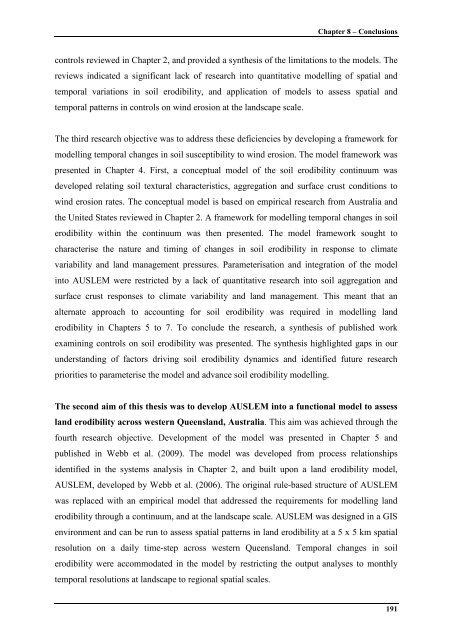Wind Erosion in Western Queensland Australia
Modelling Land Susceptibility to Wind Erosion in Western ... - Ninti One
Modelling Land Susceptibility to Wind Erosion in Western ... - Ninti One
You also want an ePaper? Increase the reach of your titles
YUMPU automatically turns print PDFs into web optimized ePapers that Google loves.
Chapter 8 – Conclusionscontrols reviewed <strong>in</strong> Chapter 2, and provided a synthesis of the limitations to the models. Thereviews <strong>in</strong>dicated a significant lack of research <strong>in</strong>to quantitative modell<strong>in</strong>g of spatial andtemporal variations <strong>in</strong> soil erodibility, and application of models to assess spatial andtemporal patterns <strong>in</strong> controls on w<strong>in</strong>d erosion at the landscape scale.The third research objective was to address these deficiencies by develop<strong>in</strong>g a framework formodell<strong>in</strong>g temporal changes <strong>in</strong> soil susceptibility to w<strong>in</strong>d erosion. The model framework waspresented <strong>in</strong> Chapter 4. First, a conceptual model of the soil erodibility cont<strong>in</strong>uum wasdeveloped relat<strong>in</strong>g soil textural characteristics, aggregation and surface crust conditions tow<strong>in</strong>d erosion rates. The conceptual model is based on empirical research from <strong>Australia</strong> andthe United States reviewed <strong>in</strong> Chapter 2. A framework for modell<strong>in</strong>g temporal changes <strong>in</strong> soilerodibility with<strong>in</strong> the cont<strong>in</strong>uum was then presented. The model framework sought tocharacterise the nature and tim<strong>in</strong>g of changes <strong>in</strong> soil erodibility <strong>in</strong> response to climatevariability and land management pressures. Parameterisation and <strong>in</strong>tegration of the model<strong>in</strong>to AUSLEM were restricted by a lack of quantitative research <strong>in</strong>to soil aggregation andsurface crust responses to climate variability and land management. This meant that analternate approach to account<strong>in</strong>g for soil erodibility was required <strong>in</strong> modell<strong>in</strong>g landerodibility <strong>in</strong> Chapters 5 to 7. To conclude the research, a synthesis of published workexam<strong>in</strong><strong>in</strong>g controls on soil erodibility was presented. The synthesis highlighted gaps <strong>in</strong> ourunderstand<strong>in</strong>g of factors driv<strong>in</strong>g soil erodibility dynamics and identified future researchpriorities to parameterise the model and advance soil erodibility modell<strong>in</strong>g.The second aim of this thesis was to develop AUSLEM <strong>in</strong>to a functional model to assessland erodibility across western <strong>Queensland</strong>, <strong>Australia</strong>. This aim was achieved through thefourth research objective. Development of the model was presented <strong>in</strong> Chapter 5 andpublished <strong>in</strong> Webb et al. (2009). The model was developed from process relationshipsidentified <strong>in</strong> the systems analysis <strong>in</strong> Chapter 2, and built upon a land erodibility model,AUSLEM, developed by Webb et al. (2006). The orig<strong>in</strong>al rule-based structure of AUSLEMwas replaced with an empirical model that addressed the requirements for modell<strong>in</strong>g landerodibility through a cont<strong>in</strong>uum, and at the landscape scale. AUSLEM was designed <strong>in</strong> a GISenvironment and can be run to assess spatial patterns <strong>in</strong> land erodibility at a 5 x 5 km spatialresolution on a daily time-step across western <strong>Queensland</strong>. Temporal changes <strong>in</strong> soilerodibility were accommodated <strong>in</strong> the model by restrict<strong>in</strong>g the output analyses to monthlytemporal resolutions at landscape to regional spatial scales.191
















